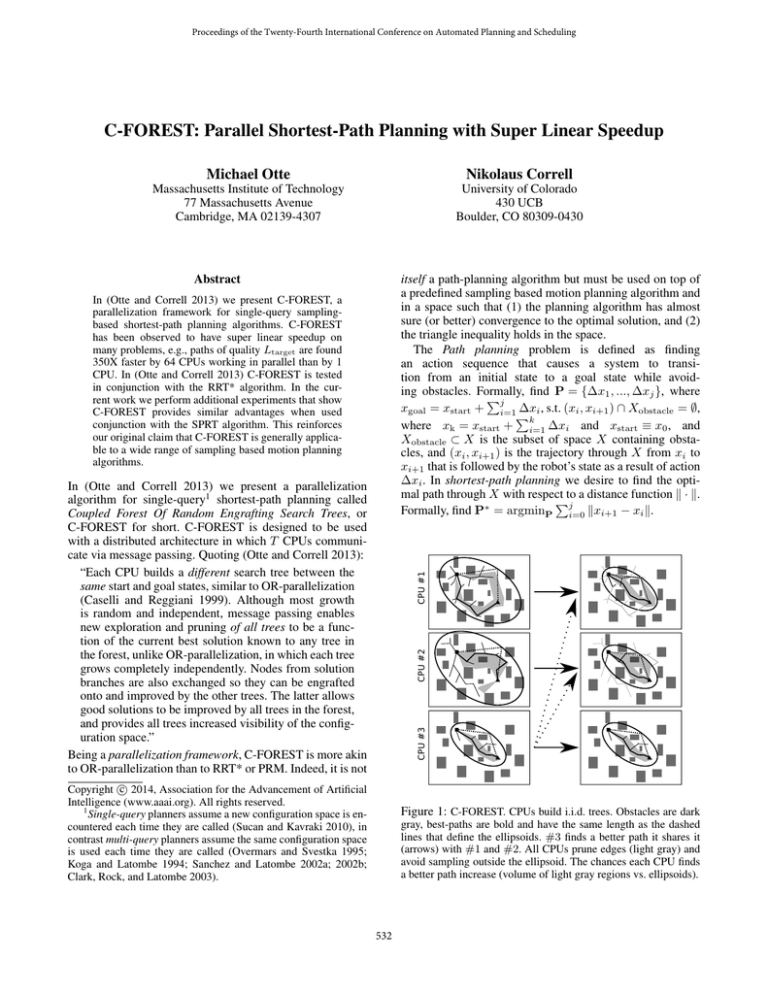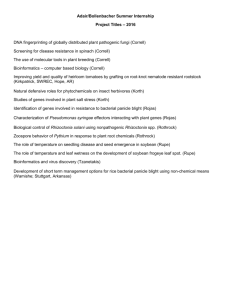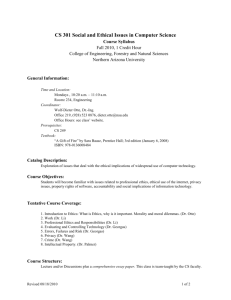
Proceedings of the Twenty-Fourth International Conference on Automated Planning and Scheduling
C-FOREST: Parallel Shortest-Path Planning with Super Linear Speedup
Nikolaus Correll
Michael Otte
University of Colorado
430 UCB
Boulder, CO 80309-0430
Massachusetts Institute of Technology
77 Massachusetts Avenue
Cambridge, MA 02139-4307
Abstract
itself a path-planning algorithm but must be used on top of
a predefined sampling based motion planning algorithm and
in a space such that (1) the planning algorithm has almost
sure (or better) convergence to the optimal solution, and (2)
the triangle inequality holds in the space.
The Path planning problem is defined as finding
an action sequence that causes a system to transition from an initial state to a goal state while avoiding obstacles. Formally, find P = {∆x1 , ..., ∆xj }, where
Pj
xgoal = xstart + i=1 ∆xi , s.t. (xi , xi+1 ) ∩ Xobstacle = ∅,
Pk
where xk = xstart + i=1 ∆xi and xstart ≡ x0 , and
Xobstacle ⊂ X is the subset of space X containing obstacles, and (xi , xi+1 ) is the trajectory through X from xi to
xi+1 that is followed by the robot’s state as a result of action
∆xi . In shortest-path planning we desire to find the optimal path through X with respect to a distance function k · k.
Pj
Formally, find P∗ = argminP i=0 kxi+1 − xi k.
In (Otte and Correll 2013) we present C-FOREST, a
parallelization framework for single-query samplingbased shortest-path planning algorithms. C-FOREST
has been observed to have super linear speedup on
many problems, e.g., paths of quality Ltarget are found
350X faster by 64 CPUs working in parallel than by 1
CPU. In (Otte and Correll 2013) C-FOREST is tested
in conjunction with the RRT* algorithm. In the current work we perform additional experiments that show
C-FOREST provides similar advantages when used
conjunction with the SPRT algorithm. This reinforces
our original claim that C-FOREST is generally applicable to a wide range of sampling based motion planning
algorithms.
CPU #3
CPU #2
CPU #1
In (Otte and Correll 2013) we present a parallelization
algorithm for single-query1 shortest-path planning called
Coupled Forest Of Random Engrafting Search Trees, or
C-FOREST for short. C-FOREST is designed to be used
with a distributed architecture in which T CPUs communicate via message passing. Quoting (Otte and Correll 2013):
“Each CPU builds a different search tree between the
same start and goal states, similar to OR-parallelization
(Caselli and Reggiani 1999). Although most growth
is random and independent, message passing enables
new exploration and pruning of all trees to be a function of the current best solution known to any tree in
the forest, unlike OR-parallelization, in which each tree
grows completely independently. Nodes from solution
branches are also exchanged so they can be engrafted
onto and improved by the other trees. The latter allows
good solutions to be improved by all trees in the forest,
and provides all trees increased visibility of the configuration space.”
Being a parallelization framework, C-FOREST is more akin
to OR-parallelization than to RRT* or PRM. Indeed, it is not
c 2014, Association for the Advancement of Artificial
Copyright Intelligence (www.aaai.org). All rights reserved.
1
Single-query planners assume a new configuration space is encountered each time they are called (Sucan and Kavraki 2010), in
contrast multi-query planners assume the same configuration space
is used each time they are called (Overmars and Svestka 1995;
Koga and Latombe 1994; Sanchez and Latombe 2002a; 2002b;
Clark, Rock, and Latombe 2003).
Figure 1: C-FOREST. CPUs build i.i.d. trees. Obstacles are dark
gray, best-paths are bold and have the same length as the dashed
lines that define the ellipsoids. #3 finds a better path it shares it
(arrows) with #1 and #2. All CPUs prune edges (light gray) and
avoid sampling outside the ellipsoid. The chances each CPU finds
a better path increase (volume of light gray regions vs. ellipsoids).
532
Related Work
in parallel /* on each CPU */
while not stopping criteria met do
x = random sample configuration space
if x can safely connect to T then
connect x to T
if kPbst k < Lold then
broadcast Pbst
if received message with P : kPk < kPbst k then
connect all x ∈ P \ T to T
Lold = kPbst k
The path planning problem is well suited for algorithms that
use parallelization. Probabilistic Road-Map (PRM) has been
shown to be ‘embarrassingly’ parallel on memory shared architectures (Amato and Dale 1999). A similar idea is presented in (Ichnowski and Alterovitz 2012) for RRT and
RRT*. Related algorithms have also been implemented on
a GPU (Bialkowski, Karaman, and Frazzoli 2011), and with
a shared memory architecture (Sucan and Kavraki 2009).
OR-parallelization over a message passing architecture is
used for feasible path-planning in (Caselli and Reggiani
1999; Challou, Gini, and Kumar 1993). The Sampling-based
roadmap of trees (SRT) feasible-path planning algorithm
has also been implemented on a message passing (Plaku
et al. 2005). Multiple trees have been used for path planning with non-distributed architectures in (Li and Shie 2002;
Gayle, Klingler, and Xavier 2007; Zucker, Kuffner, and
Branicky 2007; Ferguson and Stentz 2006; Wedge and Branicky 2008). A detailed discussion of the differences between
C-FOREST and all of these works appears in (Otte and Correll 2013). The latter extends our earlier work (Otte and Correll 2010a; 2010b) to shortest-path planning over messagepassing architectures, in general. The current extended abstract contains the results of experiments that have not previously appeared outside the first author’s PhD dissertation
(Otte 2011).
return Pbst
Figure 2: The C-FOREST Algorithm. The construction of T
depends on the planning algorithm being used (e.g, RRT*).
We assume asymptotically optimal convergence of kPbst k.
η > 1) when the Ltarget stopping criterion is used with
RRT*. Indeed, η > 9 is observed. In the current extended
abstract of our broader work, we reproduce similar results
using the SPRT algorithm.
C-FOREST Algorithm
An outline of the C-FOREST algorithm appears in Figure 2.
A detailed description appears in (Otte and Correll 2013).
Each CPU builds an independent and unique random
search tree T between the same start and goal states. Whenever a shorter path Pbst is found (i.e., on a particular CPU),
then it is sent to every other tree via message passing so that
the nodes x ∈ Pbst of its best path can be inserted into the
trees on all other CPUs.
As originally explained in (Otte and Correll 2013), the
latter exchange is beneficial in three ways: “(1) All trees
expand into regions of the configuration space that are
known to be beneficial by at least one tree. (2) All trees
can prune themselves of globally outdated nodes and (3)
focus their search by avoiding regions of the configuration space that cannot produce globally better solutions.”
For example, assuming the existence of a distance function k · k, by pruning/ignoring all points x ∈ X such that
kxgoal − xk + kx − xstart k < kPbst k.
C-FOREST’s runtime is a combination of the inherited
runtime, per node, of the underlying random tree algorithm
and the time associated with sending/receiving messages.
The former is O(c log(n)) for RRT* and O(n) for SPRT
(where n is the number of nodes in T , while c is a predefined constant used in RRT*). Let g(n) be the time required
to prune nodes from the tree based on kPbst k, and let f (i) be
the time required to insert the i-th node of Pbst into the tree.
For RRT* f (i) = O(c log(i)) and for SPRT f (i) = O(i).
Sending a message requires time O(`), while receiving a
P`
message requires time O(` + g(n) + i=1 f (i)).
Super Linear Speedup vs. Stopping Criterion
Let the wall time required to solve a particular problem with
1 or T CPUs be denoted w1 and wT , respectively. Speedup
is defined S = w1 /wT and efficiency is defined η = S/T .
Speedup measures the relative benefit of using T CPUs in
parallel (i.e., with respect to elapsed time until the solution
is found), while efficiency is inversely proportional to the
amount of total computation power used to solve a problem.
The following discussion on stopping criteria appears in
(Otte and Correll 2013):
“C-FOREST will normally be used with an ‘any-time’
stopping criterion—it will search for better solutions as
long as possible, given constraints imposed by safety,
time and/or energy expenses, etc. However, it can alternatively use a cost-based stopping criterion—running
until the first solution better than a predefined target
cost is found, i.e., until kPbst k < Ltarget , where Pbst
is the best solution so far.
By definition, S and η cannot be calculated when
an any-time stopping criterion is used (for any
algorithm)—since the any-time stopping criterion sets
w1 and wT based on external factors.
All discussions about speedup and efficiency in this extended abstract refer to the Ltarget stopping criterion. That
said, the qualitative results obtained with the Ltarget transfer to the any-time stopping criterion because they show how
much more (or less) planning time we expect would be required to get the same result using a different T .
Experiments presented in (Otte and Correll 2013) show
that C-FOREST can have super linear speedup (S > T , and
Experiments
In (Otte and Correll 2013) we perform five sets of experiments with RRT* involving four different planning problems. In this extended abstract we present two additional ex-
533
Arm Experiment, 1 to 64 CPUs, 1 tree per CPU
periments in which C-FOREST is used with the SPRT algorithm: (1) A 7-DOF manipulator arm must plan around
an obstacle and distance is defined as the total distance traveled by the end-effector of the arm. (2) A centralized2 multirobot team of four robots must plan in an office environment,
and distance is defined as the euclidean distance through the
combined configuration space of all robots.
The main difference between SPRT, which appears in Appendix B of (Otte 2011), and RRT* is that the former attempts direct connection of a new sample to every node already in the tree and propagates any resulting cost-to goal
changes out to the search-tree’s leaves (in order to maintain a
consistent graph), while the latter only attempts connection
to O(log(n)) nearest neighbors in expectation and propagates cost-to-goal changes only to those O(log(n)) neighbors (yielding an inconsistent graph). Thus, SPRT has a periteration runtime of O(n) while RRT* has a per-iteration
runtime of O(log n). On the other hand, cost-to-goal information updates much more quickly in SPRT than in RRT*
due to graph consistency vs. inconsistency.
C-FOREST with SPRT is compared to ORparallelization3 with SPRT in order to compare the
advantages of sharing data during planning vs. the purely
statistical benefits of drawing multiples samples from the
space of all random paths.
Our parallel architecture contains 64 single CPU computers (each with 1.2 GHz Xeon processors and Ubuntu operating system). Communication is over a network, and each
CPU builds a single SPRT tree. We perform 32 repeated trials per datapoint for each combination of planning problem,
parallelization method {C-FOREST, OR-parallelization},
forest sizes T = {1, 2, 4, 8, 16, 32, 64}, and stopping criterion Ltarget of varying difficulty. Note that when T = 1 the
resulting algorithm is equivalent to using SPRT on a single
tree without parallelization. Figures 3 and 4 show results.
T ime
C − F OR E ST
OR − P arallel
100
100
10
10
L t a r g et
130
140
150
170
200
E fficiency
Speedup
1
1 8 16
32
1
64
1 8 16
32
64
150
150
L t a r g et
125
125
130
100
100
140
75
75
150
50
50
25
25
0
0
1 8 16
32
64
3
3
2.5
2.5
2
2
1.5
1.5
1
1
0.5
0.5
0
0
1 8 16
32
T = CP Us
64
170
200
S=T
1 8 16
32
64
L t a r g et
130
140
150
170
200
η =1
1 8 16
32
T = CP Us
64
Figure 3: C-FOREST with SPRT vs. OR with SPRT for a
7 DOF arm. Color is target path length (Ltarget ). Dashed
lines show linear speedup (η = 1 and S = T ) with respect to
CPUs. Time (mean, standard error), speedup, and efficiency
using 1-64 CPUs, 1 tree per CPU (32 runs per data-point).
4 Robot Team Office Experiment, 1 to 64 CPUs, 1 tree per CPU
T ime
C − F OR E ST
E fficiency
Speedup
The results observed with SPRT are very similar to those
previously observed with RRT* in (Otte and Correll 2013).
While we point the reader to (Otte and Correll 2013) for
a detailed discussion, a summary appears below. Note that
sentences within quotation marks are taken directly from
(Otte and Correll 2013) and apply to experiments with RRT*
as well as to experiments with SPRT.
C-FOREST outperforms OR-parallelization on shortestpath planning problems, in general, and has better performance as Ltarget decreases. “This reflects the fact that, before the initial solution is found, there is no difference between C-FOREST and OR-parallelization.” “Intuitively, exchanging paths is beneficial because bottlenecks and other
L t a r g et
100
100
10
10
32.5
1
1
40.0
0.1
Discussion of Results
OR − P arallel
1 8 16
32
64
0.1
150
150
100
100
50
50
0
0
30.0
35.0
50.0
1 8 16
32
64
L t a r g et
30.0
32.5
35.0
1 8 16
32
64
40.0
50.0
S=T
1 8 16
32
64
4
4
L t a r g et
3
3
30.0
2
2
35.0
1
1
0
0
32.5
40.0
1 8 16
32
T = CP Us
64
50.0
η =1
1 8 16
32
T = CP Us
64
Figure 4: C-FOREST with SPRT vs. OR with SPRT, 4 robot
team in an office. 32 runs per data-point. Same key as Fig 3.
2
All robot are viewed as individual pieces of a single
larger robot in centralized multi-robot planning. The configuration space C of the single “meta-robot” is defined as
the Cartesian product over the set of configuration spaces
{C1 , . . . CR } from each individual robot 1, . . . , R. Formally,
C = C1 × C1 × . . . × CR−1 × CR .
3
OR-parallelization grows T trees in parallel that do not communicate during search
obstructions can make exploring the space difficult, and finding a close-to-optimal solution unlikely.” Coupled sampling
allows all trees to “focus effort on exploring only regions of
the configuration that can possibly lead to better solutions.
534
ning with multiple tasks in dynamic environments. 1316–
1323.
Ichnowski, J., and Alterovitz, R. 2012. Parallel samplingbased motion planning with superlinear speedup. In In Proc.
IEEE/RSJ International Conference on Intelligent Robots
and Systems.
Koga, Y., and Latombe, J.-C. 1994. On multi-arm manipulation planning. In Proc. IEEE International Conference on
Robotics and Automation, volume 2, 945–952.
Li, T.-Y., and Shie, Y.-C. 2002. An incremental learning approach to motion planning with roadmap management. In
IEEE International Conference on Robotics and Automation, 3411–3416.
Otte, M., and Correll, N. 2010a. Any-com multi-robot
path-planning: Maximizing collaboration for variable bandwidth. In Proc. International Symposium on Distributed Autonomous Robotics Systems.
Otte, M., and Correll, N. 2010b. Any-com multi-robot pathplanning with dynamic teams: Multi-robot coordination under communication constraints. In Proc. International Symposium on Experimental Robotics.
Otte, M., and Correll, N. 2013. C-FOREST: Parallel
shortest-path planning with super linear speedup. volume 29, 798–806.
Otte, M. 2011. Any-Com Multi-Robot Path Planning. Ph.D.
Dissertation, University of Colorado at Boulder.
Overmars, M., and Svestka, P. 1995. A probabilistic learning
approach to motion planning. In Algorithmic Foundations of
Robotics (WAFR), 19–37.
Plaku, E.; Bekris, K. E.; Chen, B. Y.; Ladd, A. M.; and
Kavraki, L. E. 2005. Sampling-based roadmap of trees for
parallel motion planning. IEEE Transactions on Robotics
21:587–608.
Sanchez, G., and Latombe, J.-C. 2002a. On delaying collision checking in prm planning: Application to multi-robot
coordination. The international Journal of Robotics Research 21:5–26.
Sanchez, G., and Latombe, J.-C. 2002b. Using a prm planner to compare centralized and decoupled planning for multi
robot systems. In Proc. IEEE International Conference on
Robotics and Automation, volume 2, 2112–2119.
Sucan, I. A., and Kavraki, L. E. 2009. Kinodynamic motion
planning by interior-exterior cell exploration. In Algorithmic
Foundation of Robotics VIII (Proceedings of Workshop on
the Algorithmic Foundations of Robotics), STAR, 449–464.
Sucan, I. A., and Kavraki, L. E. 2010. On the implementation of single-query sampling-based motion planners. In
IEEE International Conference on Robotics and Automation, 2005–2011.
Wedge, N. A., and Branicky, M. S. 2008. On heavy-tailed
runtimes and restarts in rapidly-exploring random trees. In
AAAI Conference on Artificial Intelligence.
Zucker, M.; Kuffner, J. J.; and Branicky, M. S. 2007. Multipartite RRTs for rapid replanning in dynamic environments.
In International Conference on Robotics and Automation,
1603–1609.
Coupled pruning reduces the amount of work required to insert new nodes into each tree.”
While larger forests always find a target solution more
quickly, the best efficiencies are observed when T < 64. An
explicit method of optimizing T is beyond the scope of (Otte
and Correll 2013) as well as the current work; however, performance appears to be stable vs. T ; changing T by 30%
has a relatively small effect on solution quality vs. time.
In practice, we believe that a reasonable approximation of
the optimal value of T can be found by tuning the parameter problems that have similar space topology and obstacle
size/density.
C-FOREST’s ability to achieve super linear speedup does
not transfer to feasible path planning. In (Otte and Correll
2013) we evaluate C-FOREST on the Alpha-1.5 benchmark,
a classic feasible planning problem, and find that speedups
are nearly always sub-linear.
Conclusions
In this extended abstract we show that C-FOREST enables
significant speedup when used with the SPRT algorithm.
This compliments our previous results in (Otte and Correll
2013) where we showed that C-FOREST provides significant speedup with the RRT* algorithm. RRT* and SPRT
have significantly different mechanics of convergence to the
optimal solution (see Experiments Section for more information). Therefore, the current results support our claim that
C-FOREST is widely applicable to many different sampling
based motion planning algorithms. This is the first time that
results regarding SPRT have appeared outside the first author’s PhD Thesis.
References
Amato, N. M., and Dale, L. K. 1999. Probabilistic roadmap
methods are embarrassingly parallel. In Proc. IEEE International Conference on Robotics and Automation, 688–694.
Bialkowski; Karaman; and Frazzoli. 2011. Massively parallelizing the RRT and the RRT*. In Proceedings of the
IEEE/RSJ International Conference on Intelligent Robots
and Systems.
Caselli, S., and Reggiani, M. 1999. Randomized motion
planning on parallel and distributed architectures. In Euromicro Workshop on Parallel and Distributed Processing,
297–304.
Challou, D. J.; Gini, M.; and Kumar, V. 1993. Parallel search
algorithms for robot motion planning. In IEEE International
Conference on Robotics and Automation, 46–51.
Clark, C. M.; Rock, S. M.; and Latombe, J.-C. 2003. Dynamic networks for motion planning in multi-robot space
systems. In International Symposium on Artificial Intelligence, Robotics and Automation in Space, 3621–3631.
Ferguson, D., and Stentz, A. 2006. Anytime RRTs. In Proc.
IEEE/RSJ International Conference on Intelligent Robots
and Systems, 5369–5375.
Gayle, R.; Klingler, K. R.; and Xavier, P. G. 2007. Lazy
reconfiguration forest (LRF) - an approach for motion plan-
535




